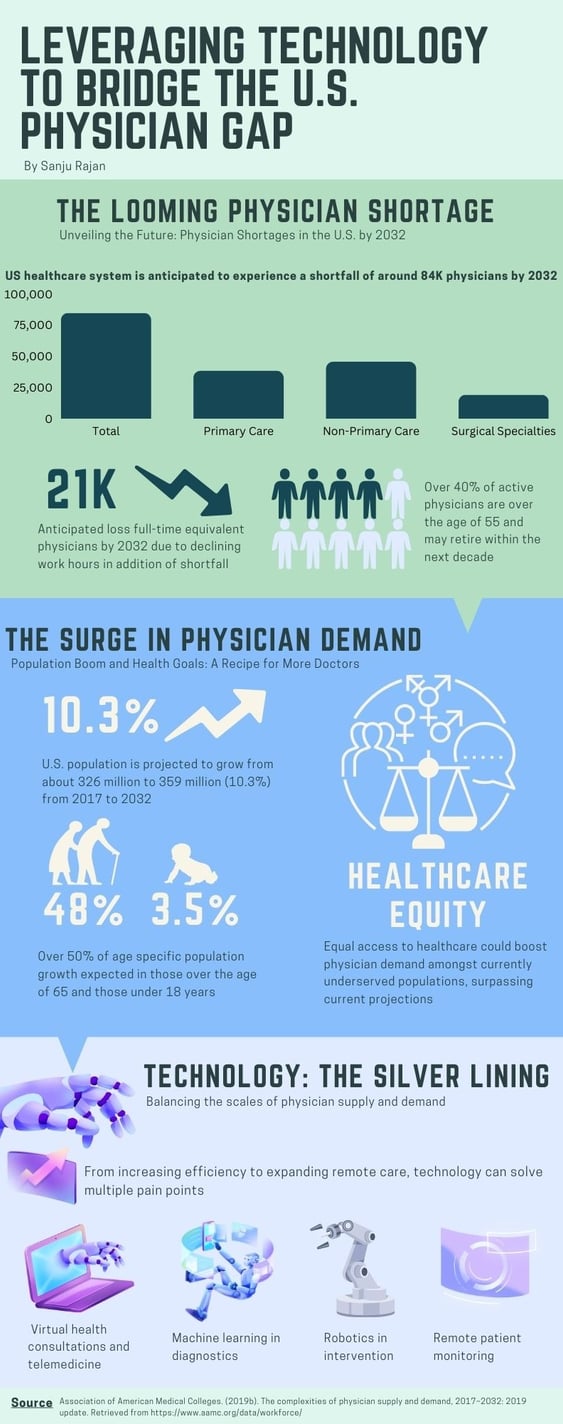Diagnosing America's 2032 Doctor Deficit
Doctor, Doctor, Give Me the News: The 2032 Physician Forecast and Tech's Role in Healing the Gap
9/22/20233 min read


Will there be enough doctors in the U.S. to cater to our needs by 2032? Unfortunately, the outlook is grim. The U.S. healthcare system is projected to face a shortage of approximately 84,000 physicians by 2032. This is not just a matter of numbers; it represents a crisis that could impact the quality and accessibility of healthcare.
The Supply Crunch
Primary Care Physicians: Often considered the backbone of healthcare, we're expected to see a deficit of about 38,150 by 2032.
Non-Primary Care Specialists: A projected shortfall of 45,300 in specialized roles.
Surgical Specialists: The numbers suggest a looming shortfall of 18,850 surgeons.
Moreover, physicians today are not working as many hours as in the past, leading to an effective loss of 21,000 full-time equivalent physicians by 2032. Additionally, with over 40% of active physicians aged 55 and older, retirements in the next decade might widen this gap. If these predictions are even remotely accurate, the consequences will extend beyond missed flu shots or routine check-ups; the U.S. will be short of a whole army of lifesavers.
Fuel for Demand
The Surge in U.S. Population: By 2032, the U.S. population is estimated to increase by 10.3%, reaching around 359 million. Notably, the most significant growth is expected in populations aged 65 and older, as well as those under 18. This demographic change indicates an impending massive demand for healthcare services.
Equity in Healthcare: The current projections might even underestimate the actual need. The nation is earnestly pushing for healthcare equity. Can you imagine if everyone received the healthcare they truly needed? If equitable access is granted to presently underserved communities, the demand for doctors might surpass even these grim forecasts.
Bridging the Supply-Demand Gap: Can Technology Save the Day?
In the face of these challenges, many see technological advancements as a beacon of hope.
Let's look at technology's most likely use cases: telemedicine and virtual consultations, machine learning in diagnosis, robotics in surgical procedures, and remote patient monitoring.
Telemedicine and Virtual Consultations: Telemedicine isn't just a buzzword; it's a functional alternative to conventional, in-person healthcare. It is literally a doctor in your pocket. It provides medical professionals with the ability to reach underserved or rural areas without the need for physical travel.
Machine Learning in Diagnosis: Machine learning algorithms can analyze data at speeds and with an accuracy level that are often beyond human capability. They can assist in diagnostics, thereby expediting patient care and potentially reducing physician workload.
Robotics in Surgical Procedures: The use of robotics in surgeries not only increases precision but also can perform specific repetitive tasks more efficiently than humans, thereby freeing surgeons for newer responsibilities. Robots have steadier "hands" than even the best surgeons. They’re not ready for their own TV drama just yet, but they’re getting there.
Remote Monitoring: Wearables aren't just for counting steps or tracking your sleep anymore. With the advent of smart wearables and IoT devices, constant health monitoring has become a reality. Such technology allows healthcare providers to track patient metrics in real-time, enhancing preventive care and reducing emergency interventions.
My Final Diagnosis
While there is no substituting the expertise and care a human physician can provide, technology can be a significant asset in tackling the looming physician shortage. Adopting a balanced approach that integrates technological solutions can pave the way for a more efficient and accessible healthcare system. A spoonful of innovation is the treatment the healthcare system needs.
We may not be able to entirely bridge the physician gap immediately, but with prudent planning, policy shifts, and technological adoption, we can make substantial progress.
Source: Association of American Medical Colleges. (2019b). The complexities of physician supply and demand, 2017–2032: 2019 update. Retrieved from https://www.aamc.org/data/workforce/
